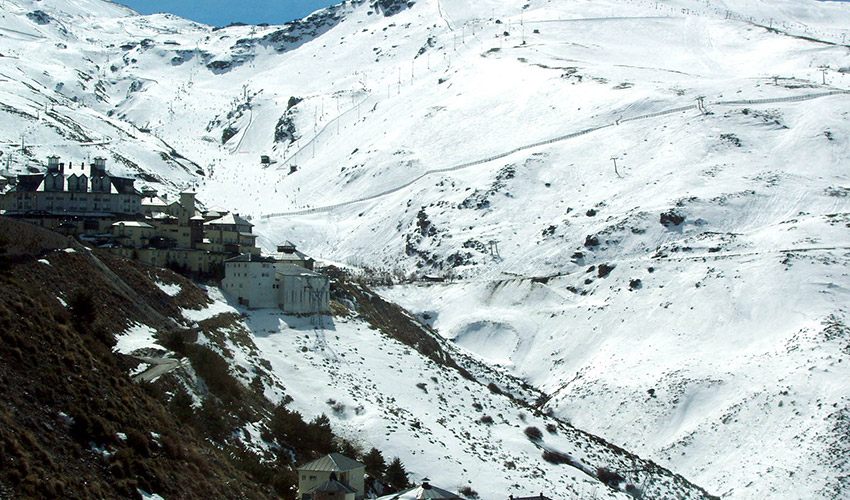Sierra Nevada

This mountain range in Spain is one of the southernmost ski destinations in all of Europe. It also contains the highest mountain of continental Spain, Mulhacén at 3,478 meters (11,411 feet) above sea level. The range towers over the city of Grenada, and offers a number of fun activities for travelers. In addition to winter slopes, visitors here can enjoy the National Park that serves as a biosphere reserve, an astronomical observatory and telescope, and access to a number of adventure guide services. During summertime, these mountains are a mecca for hiking, rock climbing, and mountain biking.
Set in the central part of the Penibética mountain range, the Sierra Nevada massif is the largest Iberian mountain area with its own structural unit. Known by the Arabs as the “Sierra del Sol”, or “sunlit mountains”, it is home to some of the most valued flora in Europe. It was declared a Biosphere Reserve in 1986.
Sierra Nevada is a mountain massif which forms a clearly distinct geographic unit. It is located to the southeast of Granada and extends to the eastern edge of Almería. It is characterised by its contrasting relief, with gentle slopes in some areas and steep cliffs in others. This reserve is home to the highest peaks on the Iberian peninsula: the Mulhacén (3,482 m) and the Veleta (3,392 m). The main plant communities to be found in this mountain massif are holm oak groves, deciduous forests of chestnuts and Pyrenean oak, high-mountain pine groves, and broom at the highest levels, where the species adopt a pin-cushion shape to protect themselves from the winter temperatures and freezing winds. The fauna includes several invertebrates which are exclusive to this massif, and particularly, over 20 species of butterfly. There are also numerous species of small birds, a considerable number of birds of prey and various mammals including the Spanish ibex which grazes on the mountain tops.
The Nature reserve
High mountains and exuberant nature in the heart of Andalusia
In eastern Andalusia in Granada and Almería you'll find the highest peaks in continental Spain. Its mountains, rivers and streams extend for 90 kilometres, bringing abundant life to the region. Populated for more than 2,000 years, the Sierra Nevada is the perfect place for witnessing humans and wildlife co-existing in the high mountains.Set in the central part of the Penibética mountain range, the Sierra Nevada massif is the largest Iberian mountain area with its own structural unit. Known by the Arabs as the “Sierra del Sol”, or “sunlit mountains”, it is home to some of the most valued flora in Europe. It was declared a Biosphere Reserve in 1986.
Sierra Nevada is a mountain massif which forms a clearly distinct geographic unit. It is located to the southeast of Granada and extends to the eastern edge of Almería. It is characterised by its contrasting relief, with gentle slopes in some areas and steep cliffs in others. This reserve is home to the highest peaks on the Iberian peninsula: the Mulhacén (3,482 m) and the Veleta (3,392 m). The main plant communities to be found in this mountain massif are holm oak groves, deciduous forests of chestnuts and Pyrenean oak, high-mountain pine groves, and broom at the highest levels, where the species adopt a pin-cushion shape to protect themselves from the winter temperatures and freezing winds. The fauna includes several invertebrates which are exclusive to this massif, and particularly, over 20 species of butterfly. There are also numerous species of small birds, a considerable number of birds of prey and various mammals including the Spanish ibex which grazes on the mountain tops.

 Spanish
Spanish German
German Dutch
Dutch